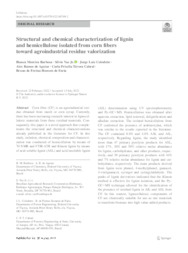Structural and chemical characterization of lignin and hemicellulose isolated from corn fibers toward agroindustrial residue valorization.
Structural and chemical characterization of lignin and hemicellulose isolated from corn fibers toward agroindustrial residue valorization.
Author(s): BARBOSA, B. M.; VAZ JUNIOR, S.; COLODETTE, J. L.; AGUIAR, A. R. de; CABRAL, C. P. T.; FARIA, B. de F. H. de
Summary: Corn fiber (CF) is an agroindustrial residue obtained from starch or corn syrup. Currently, there has been increasing research interest in lignocellulosic materials from these residual materials. Consequently, this paper is a novel approach that complements the structural and chemical characterizations already published in the literature for CF. In this study, isolation, chemical composition and characterization was conducted of hemicellulose by means of 1H NMR and FTIR-ATR and Klason lignin by means of acid soluble lignin (ASL) and acid insoluble lignin (AIL) determination using UV spectrophotometry and Py?GC‒MS. Hemicellulose was obtained after aqueous extraction, lipid removal, delignification and alkaline extraction. The isolated hemicellulose from CF confirmed the presence of arabinoxylan, which was similar to the results reported in the literature. The CF contained 8.0% and 4.0% ASL and AIL, respectively. Regarding lignin, the study identified more than 47 primary pyrolysis products for ASL, with 17%, 20% and 59% relative molar abundance for lignin, carbohydrates, and other products, respectively, and 39 primary pyrolysis products with 44% and 7% relative molar abundance for lignin and carbohydrates, respectively. The main products derived from lignin were phenol, 4-methylphenol, guaiacol, 4-vinilguaiacol, syringol and syringylaldehyde. The peaks of lignin derivatives indicated that the Klason method is effective for lignin isolation, and the Py? GC‒MS technique allowed for the identification of the presence of residual lignin in AIL and ASL from CF. In this context, lignocellulosic components of CF are chemically suitable for use as raw materials to transform biomass into high value-added products.
Publication year: 2022
Types of publication: Journal article
Unit: Embrapa Agroenergy
Observation
Some of Embrapa's publications are published as ePub files. To read them, use or download one of the following free software options to your computer or mobile device. Android: Google Play Books; IOS: iBooks; Windows and Linux: Calibre.
Access other publications
Access the Agricultural Research Database (BDPA) to consult Embrapa's full library collection and records.
Visit Embrapa Bookstore to purchase books and other publications sold by Embrapa.

